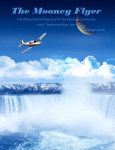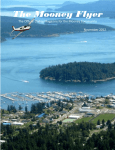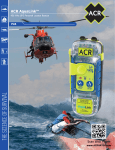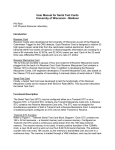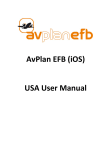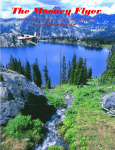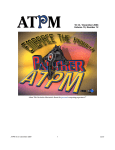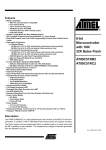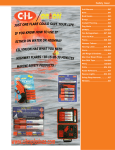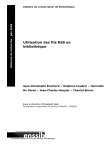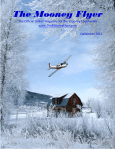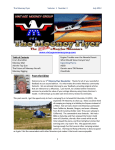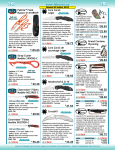Download Present Position - The Mooney Flyer
Transcript
The Mooney Flyer blouse The Official Online Magazine for the Mooney Community www.TheMooneyFlyer.com November 2014 The Mooney Flyer Volume 3 Number 11 & Mooney Polos, T’s and Hats November 2014 Order at yours at TheMooneyFlyer.com/apparel3 Proclaim Your Love for Mooneys and Speed! 2 Back to Table of Contents The Mooney Flyer Volume 3 Number 11 November 2014 Contents Features An ADS-B PIREP Phil Corman writes about flying with ADS-B IN & OUT Editors Phil Corman Jim Price When You Fail to Plan, You Just Planned to Fail Jim Price writes about surviving after an off-field landing After 50 Years, I Miss My Friends Contributing Writers Bob Kromer Tom Rouch Paul Loewen Geoff Lee Linda Corman Cliff Biggs Mike Elliott Cliff Biggs does a first-hand retrospective on Safety VIP TFR Don’t ASSUME anything about a TFR. It can only get you in deep trouble. Flying in a Mooney, but not a pilot? Get Involved Linda Corman writes about how your regular non-pilot can get more involved in Mooney flying and enjoy the flight that much more. Mooney Summit II Mike Elliott and Dr. Ron Dubin pull another rabbit out of the hat with Mooney Summit II in Panama City. Read their article on the event. To Subscribe Click Here And Then They Were Gone.. From GA that is To Advertise Phil ruminates on things that will be disappearing from GA and Mooneys.. maybe A Leak Speaks Click Here Your Mooney is constantly communicating its status to you via one of your senses. Geoff Lee asks, “Are you paying attention?” To Submit an Article Click Here In Every Issue From the Editor Appraise Your Mooney’s Value Website of the Month -- Survival Equipment website Mooney Mail – Feedback from Flyer readers Ask the Top Gun – Tom Rouch answers your questions Upcoming Fly-Ins Have You Heard the News? – Relevant GA news & links for the month Mooney Instructos Around the Country – Mooney Instructors around the USA Product Review – PS Engineering PMA450 Click Here to Subscribe 3 Click Here For Back Issues Back to Table of Contents If you would like to donate to keep The Mooney Flyer healthy, please send your donation via your PayPal account to [email protected] The Mooney Flyer Volume 3 Number 11 November 2014 Last month’s poll asked, “What Is Your Largest Maintenance Concern?” We were not surprised that Engine Top issues and Fuel Tank leaks were the top concerns of Mooney owners. It makes us wonder why the Fuel Tank issues are not addressed by engineers. Heck, even Harley Davidson fixed their oil leaking Hogs. Next month’s poll: What is your Favorite Mooney Mod? CLICK HERE to vote. Mooney Flyer Apparel Did you notice that you can now purchase very cool Mooney Flyer shirts & hats. CLICK HERE to take a look. Late Autumn.. Winter Approaching While it’s midway through Autumn, winter is quickly approaching. There is already snow in the higher elevations here in the western USA, and of course in some states in the Mid West. Most private pilots, maybe Mooney pilots also, tend to fly less in the winter than the summer and autumn. This makes sense, but some of the clearest weather can be found in winter and your Mooney will perform significantly better in cold and dense air. To be sure, you don’t want to get caught in a severe snowstorm or in icing, which is much more prevalent in the winter. So pick those “severe VFR” days and go fly your Mooney like a rocket. If the temps are below 32oF, then pre-heat your engine. In a pinch, pull it out into the sun and let it sit there for a while. Not good enough? The evening before flying, put a heavy blanket over your cowling and place a light underneath. Your engine should be nice and “startable” in the morning. Enjoy the amazingly clear air, the shorter takeoff runs, and amazing vertical climb rates. Even the density altitude is somewhat tamed in the winter… You could even experience DA below actual on colder days. In addition, 100LL prices are lower right now… Go Fly that Mooney! 4 Back to Table of Contents The Mooney Flyer Volume 3 Number 11 November 2014 Appraise Your Mooney’s Value Don’t forget about our cool new Appraise your Mooney’s Value using Jimmy Garrision’s valuation. Jimmy is from All American Aircraft, the country’s largest Mooney reseller. We have implemented the models for M20C, M20E, M20G, M20F & M20J. Click on your model to simply complete the valuation. You no longer need paper and pencil. Just another benefit to our subscribers. These forms are currently Beta test quality. Please send errors to us. M20C M20E M20G M20F M20J “Equipped” to Survive http://www.equipped.com/ So you have managed to live through an off-airport landing. Now you want to survive until you are rescued or find help. Equipped.com has forums and product reviews that will give you the information on what to put in your survival kit and get more product information on which products best meet your needs and budget. There are forums and reviews. Who knows? This kind of knowledge and equipment could just save you and your passengers’ lives. 5 Back to Table of Contents The Mooney Flyer Volume 3 Number 11 November 2014 I think the go-around procedure is particularly aggressive in the twin turbo Mooney Acclaim. Early in my training I attempted a touch and go with my Acclaim and got a taste of the impressive nose up pitching moment resulting from the application of full power. I had to push forward very hard with both hands on the yoke while applying right rudder and trimming nose down. I owned a prior Mooney M20J which I flew for about 800 hs, and had no issues with landings, go-arounds or any aggressive tendencies, like the long-bodied models, especially the Acclaim model. After reading your article, I went to the airport with an excellent instructor friend (who has no Mooney time experience). I explained the issue with the long bodied Mooney and we went flying to practice in the air first and then I performed 7-8 landings as per your recommendations. After, retracting the full flaps (during the rollout to remove any remaining lift and to allow the full weight of the AC to contact the ground,) I did notice what you say in your article, and: -The Acclaim felt more solid once the mains touched the ground -My roll-out appeared slightly shorter and -I felt I had improved control of the aircraft Unfortunately, I did not practice any go-arounds. I left that for another session. Mario P Preparing for the Go-Around: Probably the best article I've ever read about emergency landings and goarounds. Don C I have been remiss in not taking a moment to tell you what a superb job you are doing with the Mooney Flyer. Every issue is filled with good stuff and the pictures are great. I know it is a tremendous amount of work, but I want you to know it is noticed and appreciated. Ron B Very nice article by Linda Corman reviewing a Mooney Trip to Methow Valley in Washington. One small correction is that there is now 100LL available at Methow Valley. Jeff M On Anxiety: I thought Geoff Lee’s article on Anxiety hit home, especially with this older Mooney pilot. Even though I have flown for 35 years, I have found my stress/anxiety has increased with age. My response to this is to ensure my Mooney is always in a good state of operation and that I plan for those types of contingencies that Mr. Lee so deftly wrote about. The Mooney Flyer is simply awesome and terribly useful to me. Mark C On the Rise & Fall of General Aviation: For those of us still flying it is obvious that general aviation is on a major decline . As I fly into large or small airports, it’s a pretty sad thing to see many aircraft parked, with tires going flat, covers half off and at small fields more often than not, there are no aircraft in the pattern. The question is why? Here's my take on why. Cost. Yes the economy has played a role in it, but general aviation was on the decline long before 2008. So let's take a look at my view about cost. Fuel is a big cost, but really, it’s not the biggest cost. In my opinion, it is the uncontrollable cost of unnecessary mandatory upgrades. Second, is the cost to keep the aircraft flying. Send in your GPS to have the small internal battery replaced and you’ll know just what I mean. Going along with that is all the other maintenance costs. Now, before all you maintenance types get all worked up, let me say that the mechanic I use is straightforward, as are most shops. But, I have experienced just the opposite as well. Be it aircraft, avionics, a paint shop, you name it; it goes like this: Send it back and we will adjust it, or fly it back so we can look at it. Now, you have to fly it there and that's a cost. And the answer to your aircraft or avionics problem: It was a different part or now it must go back to the manufacturer. And 6 Back to Table of Contents The Mooney Flyer Volume 3 Number 11 November 2014 then there is the cost to do the check to determine what is now wrong. There’s the cost to remove it and reinstall. This is after you paid for the job to be done correctly in the first place. You aircraft owners out there know just what I am taking about. What's the answer to stop the general aviation decline and keep the cost down. My answer is, you and I can't fix it on a one to one basis. We don't have a chance. General Aviation will get smaller and smaller. You see, there's no way for you or me to know if anyone else is having the same problem with a repair shop or manufacture, and as the costs continue up, you and I will leave General Aviation. A possible answer is a master aircraft cost organization. Mike M 7 to Table of Contents Radar reflects off nearly everythingBack including clouds, but they are removed by NEXRAD if there is no precipitation. The Mooney Flyer Volume 3 Number 11 TMF Analyzes Mooney Asking Prices for October 2014 Model High Low Average M20A $40,643 $37,496 $39,069 M20C $49,500 $32,900 $42,390 M20D One market sampling $49,500 M20E $59,900 $37,500 $50,633 M20F $55,000 $39,800 $44,175 M20G One market sampling $45,000 M20J $159,000 $77,500 $91,145 M20K – 231 $121,450 $65,000 $94,250 M20K – 252 $179,000 $96,500 $146,615 M20L One market sampling $185,000 M20M – Bravo $289,000 $153,900 $174,638 M20R – Ovation $649,000 $199,900 $328,780 M20S – Eagle $179,900 $159,900 $165,000 M20TN – Acclaim $733,900 $415,000 $496,796 M22 Mustang One market sampling $135,000 Sources: ASO and Controller listings 8 Back to Table of Contents November 2014 The Mooney Flyer Volume 3 Number 11 November 2014 Flying with ADS-B There have been many articles written about ADS-B describing 1) What it is, 2) How it Operates, 3) Equipment Needed, and 4) When and What is required to be compliant. In this article, I will give a PIREP on flying with ADS-B IN and OUT. This PIREP will be based on a Garmin GTN 750 coupled with a Garmin GDL 88. The GTN 750 is Garmin’s replacement for the GNS 530 and the Garmin GDL 88 is a UAT (978Mhz UAT) IN/OUT device. The GDL 88 is not a panel mounted device, but is coupled with the GTN 750 to provide FIS-B (Weather) and TIS-B (Traffic) services. Remember, a UAT meets the ADS-B mandate if you plan to fly below 18,000’ in the United States. If you want to fly above 18,000 and outside our borders, you will need an ES, (Extended Squitter) device to be compliant. The ES operates at 1090Mhz, just like Mode C, but reports over ten times the parameters compared to a Mode C. Not surprisingly, all countries, except the USA, will mandate the ES transponder. Traffic (TIS-B) 9 Back to Table of Contents The Mooney Flyer Volume 3 Number 11 November 2014 First, let me make it clear as to what traffic you will receive. If you are within range of an ADS-B ground station, then you will receive traffic information from an ADS-R (broadcast stream). This includes all ADS-B, Mode C, and Mode S traffic. You will only receive air-to-air traffic if you are not within range. The good news is that in the US, you will most likely be in range of a ground station, especially if you are in ,or near, controlled airspaces. Note: You cannot rely on TIS-B traffic to keep you safe! You still must see and avoid if flying VFR. But it is an amazing backup system for my old eyes. In the illustrations on the previous page, the inner circle represents a radius of 2nm and the outer represents 6nm. You can zoom out to 48nm for the big picture. On the left, the traffic at your 1 o’clock is 3000’ below you and the “absolute” vector shows that traffic flying away from you in approximately the 1 o’clock direction. There is a small “down arrow” which indicates that this traffic is also descending. The illustration to the right shows the same traffic scenario, but shows the “relative” vector of the traffic. In this case you can see that the traffic is actually moving towards you at a respectable velocity, indicated by the length of the green vector. Both absolute and relative modes are valuable. It is difficult to see in this illustration, but if you “touch” traffic, there will be a detailed box in the upper right corner. This indicates the N-Number is known, light aircraft or not, CR which is its Closing Rate, TRK which is its Track and GS indicating its Ground Speed. This is very helpful. On recent flights over/near the Las Vegas Class B, we were able to see the line of airlines approaching KLAS as well as the line of airlines departing. This enabled us to adjust our flight path to ensure that we were above, or below, the jet path before Las Vegas Approach asked us to amend our direction. This type of information, many miles before a decision needs to be made, seems invaluable to us. As we approached the traffic pattern, one airplane became a TA (Traffic Advisory) due to its proximity and turned from “white” to “yellow”. At one point, the GDL 88 was concerned with our proximity and made an aural alert. This was also very helpful as the PIC was focusing outside the cockpit when operating in the pattern. Lastly, traffic can also be observed on the “map” page. The Map page shows terrain and can overlay traffic, as well as other usual overlays including Topo, Terrain, NexRad, etc. It’s very useful to fly with the Map Page active and Traffic overlays. If the traffic seems to be relevant, we can switch to the dedicated Traffic menu with 2 clicks. FIS-B Weather The ADS-B weather products are similar to the familiar XM weather. The resolution of the NexRad images is lower, but still useful. With FIS-B, you can receive both National and the more detailed Regional NexRad. In addition to NexRad, you can select/deselect METARs, TAFs, AIRMETs/SIGMETs, Winds Aloft, TFRs, NOTAMS and PIREPS. Just as with XM Weather, each weather product is updated 10 Back to Table of Contents The Mooney Flyer Volume 3 Number 11 November 2014 against a schedule and against your ability to receive it. AIRMETs/SIGMETs, METARs, NOTAMs and TFRs are updated every 5 minutes. PIREPs, Special Use Airspace, TAFs, and Winds/Temps Aloft are revised every 10 minutes. CONUS NexRad is updated every 15 minutes, but Regional NexRad every 2.5 minutes. Because the screen is a touch screen, and if you are flying an entered flight plan, you could graphically edit your flight plan by rubber banding any leg to a new waypoint in order to Warning: With the get around the weather, TFR, or Special Use Airspace. If your GPS is coupled to your autopilot, then it’s pretty hands-free. It’s always critical to know how additional Traffic and old a particular weather product is, such as METARs. All of the weather substantial Weather products you currently have enabled will show the “age” of each product. information presented Each AIRMET/SIGMET type is color coded, making it easier for this old pilot to pull up details. in both graphical and textual representations, it is important to remember to FLY the airplane and include this new information in your scan. It is unwise to focus on these very informative ADS-B graphical screens. With FIS-B weather, I have found that I do NOT need to call Flight Service or Flight Watch as often. In fact, now I usually call Flight Watch simply to make a PIREP, reporting unforecasted weather or weather encountered that’s different than forecasted. I don’t call Flight Watch to get information since FIS-B is pretty complete. If I had a wish list item, it would be that I could touch on an MOA or R-Area and see its status. But alas, that is not available, so we will still need to chat with Center or Approach controllers to get this information. Summary The downside of ADS-B is that it will cost you to install the IN and OUT equipment. The mandate remains at 2020 for ADS-B “OUT”. There is no mandate for these ADS-B “IN” services. For certain, there will be FAA startup issues. CLICK HERE to read AOPA’s take on this. After you have done the installation, it is refreshing that all of the FIS-B (Weather) and TIS-B (Traffic) services are FREE. For further information and education on ADS-B, we recommend ADS-B University. CLICK HERE to take a video tutorial. It’s very complete and will give you most of what you need to know. Ever see metal in your oil filter? Here’s an extreme amount! 11 Back to Table of Contents When you Fail to Plan, you just Planned to Fail The Mooney Flyer Volume 3 Number 11 November 2014 Murphy’s Law of Crash Survival, part one: “When you really need a crash survival kit, you won’t have one.” Part two of Murphy’s Law of Crash Survival is “When you don't need it, it just sits there in your cargo compartment.” Therefore, based on the exact science of Murphy’s law, you should get yourself a survival kit so you’ll never need to use it! Priority #1: A PLB - $250 How many of you have a 406 Mhz Emergency Locator Transmitter (ELT)? Raise your hands. That’s what I thought; not many. Let’s start with an affordable locator that will direct Search and Rescue (SAR) to your location. It’s the ACR 2881 or 2880 ResQLink Personal Locator Beacon (PLB). It’s quick and accurate and has three levels of integrated signal technology to quickly and efficiently send your position out to a worldwide SAR network of satellites. Just deploy the antenna and press the ON button. That’s it. ResQLink guides rescuers to within 100 meters or less of your position in the US. With a GPS enabled PLB, SAR personnel are typically notified of your position in as little as 5 minutes. With the 2881 or 2880, you can test the functions and verify proper operation routinely with the touch of a button. Make sure the internal electronics and GPS are properly 12 Back to Table of Contents The Mooney Flyer Volume 3 Number 11 November 2014 functioning before you leave for your next cross country flight. The 2881 is waterproof to 5 Meters. Both models are small and compact with a battery life of 24+ hours @ -4 degrees F. The ACR 2881 is a slight upgrade to the 2880 because it floats. My wife and I keep the ResQLink PLB handy in the cockpit. If we should find ourselves in a hopeless situation and “goin’ down”, the PLB is easy to find and activate. If we crash land and are incapacitated, the PLB will have already been activated – speeding the SAR process. Priority #2: A Survival Kit Our first choice is the GUARDIAN 4- PERSON DELUXE SURVIVAL KIT, $130. This kit lasts 5 – 7 days. It’s 25 lbs. available at www.livingrational.com All items are packed securely in a Red Duffle Bag with Wheels which contains extra space for your personal items. The kit includes the following: Water and Food Products 48- 4oz. Water Pouches 24 - 400 Calorie Food Bars (4800 Calories) 40 Water Purification Tablets - each tablet purifies 1 liter of water Communication Products Am/Fm Radio with Batteries and Headphones 2- Rechargeable Squeeze Flashlight - 3 LED flashlights 30 Hour Emergency Candle 5-in-1 Survival Whistle Box of Waterproof Matches Shelter and Warmth 4 Emergency Survival Sleeping Bags 4 Emergency Ponchos This kit is also available at www.survival-center.com for $120 Tool Products 2-16 Function Knives 4- N95 Respirator Dust Masks - NIOSH approved All of our kit items are packed securely in a resealable, waterproof storage bag Hygiene and Sanitation 4 - Hygiene Kits Tooth Brush Tooth Paste 9 Wet Naps Soap 6 Pocket Tissue Packs Safety Goggles Sewing Kit 13 Back to Table of Contents The Mooney Flyer Volume 3 Number 11 November 2014 First Aid Products 37 Piece Portable First Aid Kit Add a Signal Mirror from Amazon.com $5 Entertainment and Miscellaneous Products Total: $135 Notepad Pencil Deck of playing cards for entertainment Infectious Waste Bag You can also buy the Guardian 2 Person Survival kit, $62, at www.livingrational.com. It includes: 16 lbs. Water and Food Products 12 - 400 Calorie Food Bars (4800 Calories) 12 - 4oz. Water Pouches 20 Water Purification Tablets - each tablet purifies 1 liter of water Communication Products Am/Fm Radio with Batteries and Headphones Rechargeable Squeeze Flashlight - 3 LED flashlights 5-in-1 Survival Whistle Box of Waterproof Matches Shelter and Warmth 2 Emergency Survival Blankets 2 Emergency Ponchos with Hood Tool Products 2 - N95 Respirator Dust Mask - NIOSH approved All of our kit items are packed securely in a resealable, waterproof storage bag Hygiene and Sanitation 6 Packets of Pocket Tissues 6 Wet Naps First Aid Products 37 Piece First Aid Kit Entertainment Products Add a Signal Mirror (from Amazon.com) $5 Total: $67 Deck of Playing Cards After five years, replace the food bars and the water pouches – available online. I have priced the contents, both for the two person and four person survival kits. Unless you can buy in bulk, it will be very hard to build your own kit and beat the Guardian Survial Kit prices. 14 Back to Table of Contents The Mooney Flyer Volume 3 Number 11 If you have a larger budget, you might consider: The Crash Alpha kit ($170 at Aircraft Spruce) This kit is designed for 1 Person (1.5 pounds) 1.5 lbs This is designed for the pilot with general knowledge of survival techniques. This kit should only be purchased by experienced and skilled individuals. This kit includes 24 of the most essential items packed into the smallest kit practical. Weighing in at only 1.54 lbs, the general kit is small enough to fit in any flight bag, purse, glove compartment, map pouch or cargo pocket. It contains: 9 Volt PakLite with Red Flasher – 1, 1020 Pelican Case – 1, Accident Report Book – 1, Aluminum Foil – 1, Aquatabs Water Purifcation – 10, Bandaids- Adhesive Strips – 10, Bandaids-Butterfly Closure – 5, Benzalkonium Chloride Wipe – 1, Critical Action Sheet – 1, Emergency Blanket – 1, First Aid Book – 1, Fishing Kit – 1, Flagging Tape (20 Feet) – 1, Medical Gloves (pair) – 1, Multitool Knife – 1, Needles (sewing) – 2, Parachute Cord (10 Feet) – 1, Signal Mirror – 1, Snare Wire – 1, Spark-Lite Flint & Tinder Kit – 1, Splint (Small) – 1, Steri Strips – 3, Whistle (Four Function: Includes Whistle, Magnifier, Compass and Thermometer ) – 1, Zip Close Bags - 1 15 Back to Table of Contents November 2014 The Mooney Flyer Volume 3 Number 11 4.07 lbs November 2014 The ‘Charlie’ personal aviation survival kit ($345 at Aircraft Spruce) is designed for 1 Person. (4.07 pounds) This kit is designed for the pilot with minimal knowledge of survival techniques. Including 71 of the most essential items. This kit is extensive in its coverage of necessary tools and supplies. Packaged in a Pelican 1120 case, 'Charlie' is still compact and lightweight enough for easy transport and storage. It contains: 9 Volt Pak Lite with Red Flashing 9 Volt Pak Lite with Red Flashing Light, 1120 Pelican Case, 1200 Calorie Food Bar, Accident Report Form, Acetaminophen Tablets – 10, Aluminum Foil, Aquatabs Water Purification Tablets – 20, Adhesive Strips – 10, Butterfly & Knuckle Closures – 5, Benzalkonium Chloride Wipe – 3, Calcium Carbonate Tablets – 6, Chapstick, Cloth Water Filter, Commando Saw, Compass, Critical Action Card, Duct Tape -100", Emergency Bag, Eye Pad, Fire Stick, First Aid Book, Fishing Kit, Flagging Tape (20 Feet), Gauze - Triangular Bandage, Gauze - 4" x 4" – 2, Gauze - 3" x 5 yards – 2, Hand Warmer – 2, Hot Chocolate, Insect Repellant Wipe, Matches - Waterproof – 25, Magnifying Lens, Medical Grade Gloves (Pair), Medical Tape, Mosquito Head Net, Multi-Tool Knife, Needles (Sewing) – 2, Parachute Cord - 20 feet, Pencil, Playing Cards, Rain Poncho, Scalpel, Signal Mirror with Grid, Snare Wire, Spark-Lite Flint &Tinder Kit, Splint (Small), Sting Stop – 2, Sunscreen Wipe, Tea Bags – 2, Thermometer, Whistle, Zip-Close Bag - 2 Crashkit 4-7, ($926 at Aircraft Spruce) is designed for four people for seven days. (17.5 pounds) This kit is designed for use in typical GA light aircraft and commercial aircraft, contains the materials necessary to sustain four people for seven days in the event of a crash. The variation of items within the kit allows for multiple options for food, fire, water and shelter; for example, in addition to the Mainstay packaged food, a fishing kit and snare are also included. This kit contains 330 of the most essential items needed in a survival situation, packaged within an indestructible Pelican 1400 case. 17.5 lbs. 16 Back to Table of Contents The Mooney Flyer Volume 3 Number 11 November 2014 Mooney Summit II Mooney Summit II There were only 100 days to go, and it didn’t look like there would be a Mooney Summit II. Tragically, complete plans and the original registration site perished with my friend, Bill Gilliland, on July 11th. In between doses of Percocet, and other opiates, someone asked me if I wanted to go ahead and plan Mooney Summit II. Mike Elliott, Gayle Oberst (Mayor) and Dr. Ron Dubin Somewhere in my past as a musician, I was ingrained with the concept, “the show must go on”. So in this case, there was never a question and Summit II went forward. My overworked son Nick, came to the rescue. Within hours of my request, he put up a new registration web site with basic information for potential attendees. Summit II was going to be limited to the first 75 pilots and spouses; the maximum that the new seminar space in Panama City Beach, Florida could hold. I sent a call-to-action email to a number of subject matter experts and our seminar agenda was quickly filled. Word leaked out that “It’s on” and registration filled in just 2 days. We accepted standby registrations and, as fate typically has it, the few last minute cancellations allowed all of the standby registrants to attend. 17 Back to Table of Contents The Mooney Flyer Volume 3 Number 11 November 2014 Friday night, we held our welcome reception and door prize giveaway. 68 Pilots and 46 spouses, plus a half-dozen guests converged on Dr. Ron Dubin’s Penthouse Condo to get to know each other better, meet new faces and make airplane noises. Mooney International marketing director, Jared Absher, was a surprise guest, and he swore us to secrecy as he clued us in on Mooney’s soon-to-be-announce plans for the new M-10. Door prizes ranged from a free annual to a can of ACF 50. All of our door prizes were excellent. Contributors included Concorde Battery, VDC Electronics, Elite Etc., MAPA, Mooney Ambassadors, Pilot Workshops, ASL Camguard, ACF 50, Comm1 Communications, Don Muncy, Nav Strobe Lighting and Mike Hall Aviation. All of Summit II’s seminars qualified for FAA Wings credit. Joining us this year was FAASTeam Program Manager Billy Hattaway from Huntsville Alabama. JoAnn Dubin sponsored a continental breakfast both Saturday and Sunday morning. That was something that I’m sure all attendees considered generous. Our subject matter experts all were a hit. Jay Spears (Bendix King) spoke on the state of ADS-B, Paul Beck (Weep no More) gave a fantastic hands on of fuel tank repair and care. Richard “facsimile” Simile (Premier Aircraft Sales) captivated everyone by having each of us share our own 30 second aviation gem. After a short lunch break, I, along with LTC Tom McDermott, went into accident analysis with a focus on Mooney aircraft. World record holder CarolAnn Garratt gave a spousal flying course.Don Maxwell presented some incredible tips and slides on Mooney owner maintenance. Some were real and others unreal. Saturday’s seminars were wrapped up with Jolie Lucas and Mitch Latting showing their movie “Boots on the Ground”. Sunday night, Mooney International sponsored a dinner for us at the Runaway Island restaurant. This gave each of us another welcome chance to socialize and enjoy the company of other like minded pilots. Donations were accepted to help establish the Mooney Summit as a 501 (c)3, not for profit, where excess funds will be used to establish the Bill Gilliland foundation to help provide crisis therapy and emergency funding for downed pilots’ families and survivors. To this end, we will make a positive contribution to GA in an area currently not being addressed. I have been asked if we are going to do this again next year, and the answer is yes. After all, the show MUST go on! It will be better than ever. Already, we have plans underway to make this the event by which all aviation gatherings will be judged. What made the Mooney Summit II so good this time? Simply put, the attendees, the subject matter experts, the guests, the perfect weather, and the fantastic venue. Our mission statement, “to better the breed”, has been fulfilled, and we will continue to offer Mooney Summits with donated time and without agenda. Look for a 2015 Mooney Summit West. This will bring the Summit tradition to the west coast, for those Mooney drivers that would like to attend in the East, were it not for the logistics of a run to the east-coast. 18 Back to Table of Contents The Mooney Flyer Volume 3 Number 11 19 Back to Table of Contents Light rain will usually not be picked up by radar. Making matters worse is, the further the rain is from the radar, the less likely it will show up on a radar image. November 2014 The Mooney Flyer Volume 3 Number 11 November 2014 A Leak Speaks In the realm of Mooney fuel tank leaks, the particular leak described here is one of the more common “strong fuel odor in the cockpit” culprits. The odor is present when the tank is full and it’s hot outside. The fuel leaks from the tank, usually on the copilot or the cabin door side, by seeping between the upper wing skin and the main wing spar. It readily reveals its presence as a dark stain in two areas: 1) The right wheel well forward left corner adjacent to the fuselage is the easiest to see. Intuition suggests that the wing skin in this area gets a good deal of flexing exercise from the landing gear actuations and foot traffic moving to and from the cabin. 2) The fuel selector gaskets which seal the tank quantity sensors and the hose clamps securing the fuel supply line are other obvious leak sources. However, these do not provide the wheel well clues. The Mooney has a ”wet wing”, thus it does not have fuel tanks as a separate entity to contain the fuel. Instead, the wing itself is sealed in specific compartments to contain the fuel supply. If you leave your fuel tanks only partially full for extended periods, this too, can lead to leaks. In the upper areas that are not constantly kept wet and pliable with fuel, the tank sealant dries and cracks due to age and temperature. This is a prime contributor to tank leaks. Fuel leaks plague most of the existing, ageing Mooney fleet. One would hope that the new Mooney has gained some technological advances in the tank sealing domain! There are a couple of notable companies that specialize in completely resealing Mooney tanks, but the process is financially daunting for the average owner. The last number that I heard was between $7,500 and $10,000. The process involves chemically removing all the old sealant and totally resealing the tank seams with fresh sealant material (PRC). The process is labor intensive, but if the aircraft has multiple leaks, a total reseal of both wing tanks can end up being less expensive than using the local FBO to chase each leak – usually with no permanent success. The closest company to California that offers complete fuel tank sealing is Advanced Aircraft in Troutdale (KTTD), Oregon. They are also a Mooney service center. (4 hour trip). Willmar Air Service in 20 Back to Table of Contents The Mooney Flyer Volume 3 Number 11 November 2014 Minnesota (KBDH) is the other company, but their location presents a much longer, thus more expensive excursion for Californians. (8 hour trip) Fuel odor in the cabin comes from the same general area as the evidence presented in the wheel well, but on the other side of the wing rib that abuts the fuselage, It is hidden behind the side wall carpeting below the door entrance. When the carpeting is removed, the fuel stain will be exposed in the right side rear corner. The closest access to this leak is via the fuel tank access plate on the underside of the wing. The wing tank access plate adjacent to the cabin door provides no direct view of the leaking area inside the tank and is located further away from the subject area. The mechanic at your favorite FBO is faced with draining the fuel tank, and then removing some or all of the foregoing access plates. He then will need to either clean, plus abrade the suspected leak area, or totally remove the old sealant on the particular seam. Fresh sealant is then applied to the subject area. There are many forms of fuel tank sealant available and all have different cure times and various forms of application. One has to trust that the mechanic has had sufficient experience and practice at performing the meticulous task of application and hope that he has used the best sealant. Upon completion and prior to sealing and securing the access plates, the mechanic will perform a very careful examination of the inside of the tank for any loose debris or cleaning material. In order to determine the suspected leak location on the subject aircraft, we filled both tanks absolutely full to the rim and were immediately exposed to the overpowering odor of fuel in the cockpit. After leaving the aircraft overnight, the smell was in the small hangar. The next day, we removed about 4 gallons of fuel from the right, (suspect tank) and let the plane sit overnight. Eureka! The odor had gone away. Repairs were undertaken on that leaky wing tank and the plane is, thus far, free from fuel odor in the cockpit. One of the exciting moments of my flying career has been an engine failure just after liftoff, subsequent to a tank resealing job. Some chemical fluid used for cleaning/softening the sealant area was left in the tank and arrived at the fuel flow divider at an inopportune time. Just in case you are wondering, I had very carefully and generously sample drained the fuel system twice before that event. Luckily, I managed to land on the last 25% of the same departure runway and simply ran off the end of that runway into a flat field. No damage was done, other than some premature aging on my part. 21 Back to Table of Contents The Mooney Flyer Volume 3 Number 11 November 2014 When your Aircraft Speaks For example, the engine on one of my student’s aircraft “spoke” by exhibiting metal particles in the oil filter. Analysis revealed that the particles were comprised of aluminum shavings. The gudgeon pin (wrist pin) on the left is composed of a hardened steel bearing surface. It also has an aluminum plug that protrudes from either end of the pin. The protrusions should be identical in length. It can be seen that on the left end, the aluminum plug is much longer than on the right. As the piston travelled up and down in the cylinder, the right side of the pin had been cleanly shaved down from its original length by the bottom edge of the cylinder. The bright shiny area shown in the right photo reveals the tracking mark on the cylinder wall. The problem was revealed by a bore scope inspection of the cylinder subsequent to finding metal particles in the oil filter. A new cylinder assembly will be needed to remedy the situation. Analysis of the composition of the metal particles (Aluminum) was the prime clue to locating the source of the particles. Conversation with a noted engine shop reveals that the pin wear displayed above is not uncommon and is a prolific provider of metal particles in the oil filter. The engine was running fine, but the aircraft was trying to communicate an impending issue. Same old song. You must listen when your aircraft “speaks” to you. 22 Back to Table of Contents The Mooney Flyer Volume 3 Number 11 November 2014 Flying in a Mooney Get Involved by Linda Corman As my readers know, I usually write about places to go and things to do in your Mooney. In this issue, I have decided to write about how you and your pilot can become a Mooney team. I am not a pilot and never wish to actually fly the plane. However, that being said, I love to fly and get to new and exciting places quickly. I am going to give you some small ways in which you can become more involved and familiar with your Mooney and help out your pilot. I have also found that it makes flying more fun to be part of the team in the cockpit. PREFLIGHT When we first open the hangar, I always remove the Pitot cover and put it inside the cargo area on the hat rack. I then help my pilot push the plane out. As he is usually busy doing an initial pre-flight, and generally getting ready to power up, I close up the hangar and lock the door. We usually have to taxi to the gas pumps for fuel. This is where we do our thorough preflight checks around the plane. I have my own little checks that I do. First, I look at the tires to see if they might need some air. Then I walk around, looking for possible loose or missing screws. I have learned that both screws and “camlocks” can get loose, so I check everything. At this time, I also look at the tail area where there are large screws, to make sure everything looks tight and secure. This is not a walk around that the pilot does, but it is just my way of helping out with a second set of eyes. At the gas pumps, I hook up the static line to the plane and then turn the gas pump on. This way the pilot can start the credit card machine and type in all that needed information. He then pulls out the gas line and starts pumping fuel. If he wants to fill each tank with a specific amount of fuel, I usually read off the amounts so he doesn’t have to walk back to the pumps to read the amount loaded. I learned that he does this when our Mooney will be filled with passengers and/or baggage. By not filling the tanks, he ensures that the allowable weight limit is not exceeded. After refueling, we then taxi out to the runup area. This is the time I look at the dials and gauges inside the cockpit. I do not know what they all do; I just know what they should look like. So I have developed a mental picture of where all the dials are – in the green and generally the same as previous flights. My pilot is very good about letting me ask “dumb” questions, so I learn something new on most flights. I check a second time what gas tank side we start with, in which position the flaps are in, and that the fuel boost is off. He has forgotten to shut it off a couple of times, so I feel like a good team member. Of course, my pilot is also doing his routine. FLIGHT We both check the door to make sure it is closed and locked before we take off. Our door has “2 clicks” when it is closed and secure. As we lift off and become airborne, I check that the landing gear is up and locked and say out loud, “gear up and locked”. My pilot also repeats this out loud. If we are using flight following, I know how to use the transponder and I insert the ATC assigned code. I learned, over time, that the transponder identifies our plane from all the others on radar and that each plane gets a unique 4 digit code. We now have a new GPS with all kinds of cool things which I can look at and switch from setting to setting if I want. I can look at the weather at our destination, airport runway headings, and the best thing is, we can see other airplane traffic. Of course, I only use this instrument when asked by 23 Back to Table of Contents The Mooney Flyer Volume 3 Number 11 November 2014 my pilot. I am another set of eyes in the cockpit to help see other planes and fly straight and level when needed if my pilot is busy doing something else. These are all easy things that make flying more fun and I stay engaged with the pilot and more informed about the plane functions. This also helps if I feel concerned about something in flight so we can discuss what is happening. Sometimes, right after we level out at our altitude, I can feel a slight bit of vibration. If I mention this, he adjusts the propeller just a tad, and the vibration is eliminated. LANDINGS The last thing I do is to help with the landing. I don’t mean I actually land or anything. I look out for other planes in the pattern and after he has put the landing gear down, I call out loud that the gear is down and locked. We do this three times to ensure that we never experience a gear up landing. I confirm the gear is down 1) Immediately after he lowers the gear, 2) As we turn towards the runway, and 3) As we come over the numbers. I ask him to acknowledge me each time. I check the light on the panel which indicates gear, then I Recently our Landing Gear look at the box between the seats that indicates gear down and locked. down & locked light did not As we approach the end of the runway, I start telling my pilot his air indicate that the gear was speed and start counting down as we slow for landing. I also take a last down & locked. I was look at the windsock and try to determine the wind direction. I have used very generic terms for what I do because most non-pilots don’t know aviator lingo. To me, much of the time when pilots are discussing all that goes on with aviation, I am lost with all the three letter acronyms and technical terms that they use. I hope this article will help the non-pilot become more involved with the plane and with the details of flying our Mooneys. I hope the pilots will encourage their right seat person to take a more active role in flying and help them overcome any fears they might have in dealing with flight. I learn more, get more involved and it makes me feel like a team member in the cockpit. This makes the whole experience of flying just that much more enjoyable. I enjoy helping in these small ways and I also like to say, “I’m just out for the ride. Let me look at the beautiful scenery while you fly us to our fun destination.” concerned and brought it to his attention. He looked down on the floor to the more reliable and mechanical indication that the gear was down & locked. Then he pushed a “test” button which lights up all the lights, and the Gear Down light was apparently burned out. Disaster avoided!!! Please send any other items that your non-pilots do to be involved in the joy of flying your Mooney. CLICK HERE to send us what other items you do as a team. 24 Back to Table of Contents When it Comes to VIP TFRs The Mooney Flyer Volume 3 Number 11 November 2014 – Plan Carefully! How may Red Flags would you tolerate? HISTORY OF THE FLIGHT On October 2, 2012, about 2024 Pacific daylight time, a Piper PA-28-180 sustained substantial damage when it struck high power tension lines near the Beatty Airport (KBTY) Beatty, Nevada – about 120 miles Northwest of Las Vegas. The sole occupant of the airplane, a commercial pilot, was seriously injured. Visual meteorological conditions (VMC) prevailed. That day, the pilot departed Snohomish County Airport in Everett, Washington with three planned fuel stops en route to Henderson Executive Airport (KHND), Henderson, Nevada. He knew that there was a published VIP Temporary Flight Restriction (TFR) over Las Vegas, but did not have all the facts about the TFR. He thought that he could land at KHND before the TFR would become active. At 1520, the pilot departed on the last leg of his cross country from Reno/Stead Airport (KRTS), Reno, (KHND). COMMUNICATIONS Prior to departing KRTS, the pilot called the Reno Flight Service Station (FSS). Here is a synopsis of that conversation: The pilot told the briefer that he was concerned about the Las Vegas TFR and getting into HND. He thought that he could fly into HND and that the TFR would be in effect the next day. The Reno FSS briefer advised him that the TFR was currently in effect and if he wanted to land at KHND, he would need to file the appropriate flight plan, squawk the proper code, and be in contact with ATC. Our accident pilot asked the briefer if he could give him the code. The briefer advised him that ATC would want to talk to him in the air and he could get the code from approach control. The pilot filed a Visual Flight Rules (VFR) flight plan from KRTS to KHND, but he was still unclear on whether the TFR would prevent him from landing at HND. Air Traffic Control (ATC) could authorize transit operations through the restricted area, but would they? He really needed more information, but launched anyway. TFR procedures require that all aircraft must be on an IFR or VFR flight plan with a discrete code assigned by an ATC facility [such as the appropriate Center or Approach Controler]. [If departing from an 25 Back to Table of Contents The Mooney Flyer Volume 3 Number 11 November 2014 airport within the TFR], aircraft must be squawking this discrete code prior to departure and at all times while in the TFR. After topping off the fuel tanks, our aviator departed Reno/Stead and activated his VFR flight plan for the 320 NM flight to Henderson. For some reason, after takeoff, he chose not to contact ATC, (NorCal Departure, 126.3). Instead, he waited until he was about 40 miles west of the Las Vegas VOR to radio ATC. He tried two frequencies, but was unable to make contact. Without the all important discrete transponder code, he could not proceed to the Las Vegas area and land at KHND. 26 Back to Table of Contents The Mooney Flyer Volume 3 Number 11 November 2014 Things were really headed South. He was low on fuel with darkness closing in, so, he decided that he would divert to KBTY. He initiated a straight in visual approach to runway 34 and configured the airplane for landing. As he approached the airport, he saw the airport beacon but no other airport lighting, despite his attempts to activate the airfield lighting on the CTAF, most likely because KBTY was NOTAMed closed. During the approach, the airplane struck high tension power lines about 1 mile south of the runway. The Piper Pilot most likely flew a lower than desired approach altitude due to the night time conditions and featureless terrain. A REVIEW OF VIP TFR RULES AND PROCEDURES A. All aircraft operations within the 10 NMR inner core(s), are prohibited except for: Approved law enforcement, military aircraft directly supporting the United States Secret Service (USSS) and the office of the President of the United States, approved air ambulance flights, and regularly scheduled commercial passenger and all-cargo carriers – Heck almost everything, except GA. To enter the dreaded 10 nautical mile radius or Inner Core, Mooney pilots need not apply! B. All aircraft operating within the outer ring(s) are limited to aircraft arriving or departing local airfields, and workload permitting, ATC may authorize transit operations. Aircraft may not loiter. All aircraft must be on an active IFR or VFR flight plan with a discrete code assigned by an air traffic controller. Aircraft must be squawking the discrete code prior to departure [from an airport within the outer ring(s)] and at all times while in the TFR and must remain in two-way radio communications with ATC. 27 Back to Table of Contents The Mooney Flyer Volume 3 Number 11 November 2014 Even if our pilot could have landed safely at Beatty, his night would have been quite interesting. He would have found that Beatty does not have Aviation fuel and it’s a 3.6 mile walk to the Atomic Inn. CLICK HERE TO “VOTE” AND SEE HOW OTHERS FEEL ABOUT IT. DON’T TAKE CHANCES By simply going to http://tfr.faa.gov/tfr2/list.jsp , you can check a VIP TFR’s Beginning Date and Time and its Ending Date and Time. You can also see a graphic depiction of the TFR and read about all the procedures you must follow. The National Transportation Safety Board determines the probable cause(s) of this accident to be: The pilot’s inadequate flight planning, subsequent loss of situational awareness, and failure to maintain clearance from the power lines during a dark night approach to a closed, unlit runway. 28 Back to Table of Contents The Mooney Flyer Volume 3 Number 11 November 2014 And Then There Were None by Phil Corman Things That Will be Disappearing from GA Airplanes For years and years not much really changed on Single Engine Piston General Aviation airplanes. Over the past 20 years, the biggest changes were the introduction of Composite Aircraft and Glass Panels. In this article I will focus on a handful of things that I think will be disappearing. #1: The GA Pilot. We are having a little fun here, but the truth is that the GA pilot population is shrinking. #2: Mixture & Prop Controls. We don’t see these controls going away too quickly, but think about it. With the preponderance of digital engine management tools, there is less and less need for a Mixture Control. On the Prop side, we are not saying that constant speed props are going away. Howeve, digital controls based on power settings, airspeed, etc., can probably set the prop controls for optimal conditions in the near future. This simplifies the PIC’s workload as well. It’s analogous to cruising on autopilot. It seems that the autopilot keeps a straighter line and more level altitude than most PICs. #3: VORs are already being decommissioned by the FAA, albeit at a slow rate. We often lament that pilots are getting increasingly “lax” and losing VOR navigation skills. The reality is that the magenta line gives significantly improved situational awareness, is more accurate, and pretty darn reliable, especially if you include a redundant unit. That’s always a good thing in airplanes. #4: ADFs are all but gone now. This technology has been around since the Great Depression, which is how I felt about learning to use them in my Primary Training. My grandfather said he used to fly “a wire”. He turned an antenna until the tone was loudest and that was the bearing to the station. I guess I’ll never be a true stick and rudder guy until I master this lost art. 29 Back to Table of Contents The Mooney Flyer Volume 3 Number 11 November 2014 #5: Steam Gauges are the next things to disappear. Most of us Mooney pilots were reared on steam gauges, dependent on vacuum pumps and analog indicators. Whether you love these instruments and will die with them in your panel, or have gone to “glass panels” such as the Garmin 500 or Aspen PFD, steam gauges will go the route of two wings on airplanes – romantic, but outdated and disappearing. #6: I saved the most controversial issue to us Mooney pilots until last. That is Retractable Gear. We love our metal Mooneys, but the reality is that Composites will soon utterly replace those metals. Composites are stronger and can be made thinner. With a thinner wing and improved aerodynamics, where will we be able to retract our gear in a thinner wing? My Dad used to say that “Real Airplanes” had two wings and a round engine. Well the more things change, the more they stay the same. To this Mooney pilot, real airplanes have steam gauges, retractable gear, hydraulic flaps, and Johnson Bars. Enough said. 30 Back to Table of Contents The Mooney Flyer Volume 3 Number 11 November 8, Vero Beach, (VRB) December 13, Punta Gorda (PGD) Fort Myers, FL February 6-8, 2015 Santa Maria, CA April 24 -26, 2015 Chattanooga, TN June 5-7, 2015 Atlantic City, NJ September 11-13, 2015 Fort Worth, TX October 23-25, 2015 31 Back to Table of Contents November 2014 The Mooney Flyer Volume 3 Number 11 November 2014 Send your questions for Tom to [email protected] Q1: Under what conditions should I do a Top Overhaul? When having a cylinder problem, there are times when you have to consider a Top Overhaul. A. When you find a crack B. When compression drops below acceptable limits. The methods to determine limits are different between TCM and Lycoming methods, so I will refer you to the OEMs Service Manuals. C. When it is determined the cylinder is "pumping " oil. This is usually the result of a stuck or broken oil control ring. The most obvious indicator is oil in the lower spark plug, resulting in high oil consumption. D. Any indication of a valve leak during a compression check. Some of these problems could be solved without a Top Overhaul, like just replacing an oil ring or fixing a leaking valve. But, in all cases, the cylinder needs to be removed and then we decide what action to take. There are several options, usually depending on engine time, cylinder time, hone and re-ring, etc. Q2: When should I change "the donuts", shock discs? The first part of the answer is easy. There are "gap" limits for every model in each service manual. Ranges from "O" gap on the nose gear on all models to as much as 3/4 inch on the long bodies. To me, the most important guidance is not in the manual. When you jack the airplane, check the main gear for looseness by trying to push the gear fore and aft. We have found many that have discs that have become hard and they don't expand on extension. Also, there is a very big gap on the top of the discs which makes for a heavy shock to the wing on landing. This needs to be checked immediately when the plane is jacked, as the older discs will expand slowly, when they should expand quickly. All shock discs have the date of manufacture on them, and age can be a clue to the elasticity of the donuts. I have seen many as hard as a hockey puck. New item I have been asked many times by customers who heard that Mooney was changing the time recommended for no-back clutch spring changes from 1000 to 2000 hrs. As of the last Service Manual revision, the recommended time is still 1000 hrs. What Mooney has done is to move some requirements from Chapter 4, (Mandatory) to Chapter 5 (Recommended). SB M20-282A is still 1000 hrs. But it is only recommended. For your info, a new gear actuator is on the north side of $14K. 32 Back to Table of Contents The Mooney Flyer Volume 3 Number 11 November 2014 After Fifty Years, I Miss My Friends A Retrospective on Safety As I look back on my 50+ years of flying, I find myself missing the friends that have left me over the years, due to aviation accidents. I also find myself trying to pass along ideas on safety to new or younger pilots; ideas from my experiences and from those who have gone on before me. Sometimes it is received well and other times it seems to be an imposition on a pilot’s time. As a student of aviation history, I can see where progress in aviation safety directly parallels accidents in aviation. IFR flight and its equipment were brought about by the need to improve bad weather flying. The progress from bonfires and automobile headlights to lighted airports was followed by standards in runway lighting and approach light systems. Lighted Airways led to Low Frequency Ranges and Colored Airways. ADF approaches and Non-directional Beacons led to Omni directional radio stations and VOR navigation. From there, GCA Approaches led to ILS approaches and full Auto-land CAT III ILS equipment. Now we have GPS navigation and LPV approaches to near ILS minimums into airports that heretofore were denied approaches with low decision altitudes (DAs). All were brought about by the need to increase safety in flying. Someone paid a price for these improvements in the School of Hard Knocks. These items that I have mentioned are all about the hardware part of the equation, but what about the pilot side of the problem? Unfortunately, General Aviation does not fair as well as Commercial Aviation in this regard. We can all think of or remember a few unfortunate accidents that make the news, but an accident doesn’t ring true until it happens to someone we know. None of us is immune to making mistakes. Big or small, we all make them. However, if we stay vigilant, we will be able to “break the chain” leading to an accident before it happens. Every flight is a balance between safe and unsafe in one form or another. It is up to us as the Captain of our ship, to make the balance on each and every flight weigh in favor of safety. “Good enough” does not cut it in our business. If I may, let me relate some happenings that I know of personally. All the stories are true, but all the names have been changed. I knew each one of the pilots personally. When I was in high school and learning to fly at the local airport, I had a couple of classmates that were also new pilots like me. We were just young kids, 16 or 17 years old and interested in flying to the detriment of our school studies. One of these friends was Kelly. We both flew Cessna 150s back then as many new pilots did. We could rent them for $10/hr WET! Of course, we had to work 7 hours washing and fueling airplanes to get 1 hour of flight time. As it turned out, Kelly was the first friend I lost to aviation. Kelly’s funeral was the first funeral I ever attended. Hard Lesson #1 – One summer, he and another high school buddy flew out to a lake in the western United States and landed on the shoreline. On takeoff they never got out of ground effect and dropped into the lake where Kelly drowned. High altitude (4,000+MSL), high temperature (90 degrees), heavy (2 good sized people in a low powered Cessna 150 with half fuel) and a rough, unimproved “runway” (lake shore), does not make for a good outcome. Any one of the 4 items mentioned would probably have broken the chain to this accident. All 33 Back to Table of Contents The Mooney Flyer Volume 3 Number 11 November 2014 the items were in view, but just not seen. Sometimes saying NO is the hardest thing to do, but NO is always an option. Hard Lesson #2 – Many years later I had two friends, Wally and Billy, who were flying a Lockheed Jetstar. They needed to get into a small strip in northern New York State on a foggy night, but wound up on a mountainside, never to be heard from again. They were very experienced pilots. Both were very professional, but for some reason, this night, they dropped their guard. Night IMC with low visibility requires the utmost attention to procedures. The need to “get in” can never trump the “need for safety”. Sometimes you have to go somewhere else. Hard Lesson #3 – I had a very experienced friend that had flown everything! Experimental jets (and I mean the newest and most secret military stuff), raced small single engine planes, flew his own Bonanza, tested the newest helicopters. It goes on and on until one day he was ferrying a Super Connie and went down right after takeoff. The investigation came out and surmised that the throttles had not been secured with the friction lock and vibration had backed them off. The manifold pressure had dropped to a point where the airplane could not fly anymore and it went down into a row of trees. Anyone, and I mean ANYONE, no matter what their experience, can make a mistake. Any one of the three guys in the cockpit could have seen the throttles backing off but they didn’t. We all have to be vigilant on every flight we make to “break the chain”. Hard Lesson #4 – My friend Sally had just received her Instrument Rating and jumped at a chance to fly a single engine Comanche from one airport to another in the LA Basin one rainy afternoon. Unfortunately, she only made it a few miles before hitting a hillside after losing control right after takeoff. All that could be determined was that she got disorientated in the clouds and couldn’t recover. You may have a new IFR rating, but that doesn’t mean that you can jump into an unfamiliar airplane on a crummy day, by yourself, and have a good outcome. Your first ventures into real IMC must be planned with the utmost of care. If you are “low time anything” you need to be extra vigilant in what you do. Many years ago, a study showed a pilot’s propensity for an accident verses hours accumulated in flying. It showed a steep climb in accidents until about 1,000 hours. It rounded off and started down at about 1,200 hours and then tapered off slower than going up after that. Fortunately, I read that before I had 1,000 hours and heeded its findings. Hard Lesson #5 – My friend Ralph was interested in all things aviation. He had many ratings and flew a Chance-Vought WWII Corsair. WOW, what an airplane. Bent wings, big, smelly radial engine. It went fast and had the “Corsair whistle” when it went by. Nothing sounds or smells as good as a round engine (and I don’t mean a jet!). Being a WWII fighter, the Corsair was stressed for aerobatics and Ralph liked to go round and round doing them. Doing them at low altitude did not work out for Ralph though, as he went into the ground at the bottom of a loop that was started at too low of an altitude. Pushing the envelope may have serious consequences. In 50 years of flying I have seen “the edge”. Trust me when I say there is no need for you to go see it. Don’t push the envelope. It ain’t worth it. 34 Back to Table of Contents The Mooney Flyer Volume 3 Number 11 November 2014 Hard Lesson #6 – ICE KILLS! I made friends with a very good Doctor of Radiology many years ago. We met at the airport as he had a V tail Bonanza based there. He was not your typical Doctor. He took flying very seriously and didn’t let his MD degree get in the way of taking instruction in flying. He wanted to be safe. Let’s call him Joe. Joe did a fair amount of flying and went for his IFR rating and did very well at getting it done. He was meticulous in his flight planning and execution of his flights. Joe and I got along very well together and then Joe moved away. Having learned to fly on the west coast he was taught that if caught in an icing environment, if he climbed 2000’ to 4000’, that would probably get him out of the ice and away from the rocks. When he moved away, he moved to the Midwest. One day while flying from Canada to the USA, he encountered ice. He asked for higher and went from 9000’ to 11,000’. Still picking up ice, he asked for higher again, and got 13,000’. Still picking up ice he asked for 15,000’. After leaving 13,000’, RADAR lost him. The plane was found in a lake, missing its V tail. The accident summary indicates that he had a big build up of ice on the wings at 13,000’. He attempted to climb again and when the airspeed dropped a little, he stalled (due to the higher stall speed with ice), and went out of control. The sad part of this incident is that the clouds had a ceiling of 6,000’, where he would have found warmer air with no ice and totally flat land below with no rocks sticking up. Had he only gone down and not up, he’d still be here today. Be aware of all your options on every flight. ALWAYS HAVE A WAY OUT OF ANY SITUATION, PLANNED WAY IN ADVANCE! Look at everything and keep a constant eye out as your flight progresses. Never put yourself in a box with no way out, never, never, never. I have a few more stories but I’ll leave it here. I also have a personal rule that I follow that I’d like to pass along. It’s my “Rule of 3”. If I’m planning on flying on any particular day and things go wrong even before I leave home for the airport, I start to count each occurrence. Let’s say that I go out the door and forget my airplane keys and I have to go back for them. That’s count number one. Let’s say the car doesn’t start and I need to jump start it. That’s count number two! If anything else unplanned happens before I get airborne, that’s count number three and I cancel flying for today. It doesn’t matter what the three things are. They just tell me that my mind will not be totally concentrating on flying that day and I need to wait for a better day. My “Rule of 3” just might work for you. Try it. And yes, I have cancelled on the count of 3! Flying is like a baseball game. We all enjoy playing it, but the opposite side is trying to throw us curve balls at every turn. Our job is to hit each and every one of them. My intent is not to scare any of you about flying, but only to say that safety in flying is a never ending game. We are always at bat and we can never let ourselves strike out. Fly safe and enjoy your Mooney! 35 Back to Table of Contents The Mooney Flyer Volume 3 Number 11 November 2014 November, 2014 FltPlan Go Supports Multiple ADS-B Receivers FltPlan Go for iPad gives you the freedom to choose which ADS-B receiver you’d like to use. Our iPad FltPlan Go app currently works with four different ADS-B units: Sagetech Clarity, Dual XGPS170, Flight Data System's Pathfinder, and the SkyRadar DX. We will be adding more receivers to the list in the future. Where some apps may lock you into using one brand of ADS-B receiver, FltPlan allows you to select your own, based on your needs and your price range. Conversely, if you decide to use an app other than FltPlan Go (we can’t imagine why you would), you’re not stuck with an unusable receiver that you paid hundreds of dollars for. When you use ADS-B in conjunction with FltPlan Go, you get access to NEXRAD, METARSs, TAFs, NOTAMS, and PIREPs. As always, FltPlan Go is free. After all, you’re not getting free weather if you’re paying for a subscription to your app. To download the free FltPlan Go app, visit the iTunes App Store and search for FltPlan. LogTen Pro X Released for all Apple devices LogTen Pro X is the world’s most advanced pilot logbook platform. And with incredible new capabilities and features designed to take full advantage of iOS 8, and the powerful new iPhone 6, not to mention Yosemite and iCloud, LogTen Pro X is so much more than your logbook. READ MORE 36 Back to Table of Contents The Mooney Flyer Volume 3 Number 11 November 2014 Flight Aware Introduces More Features Flight-tracking company FlightAware has launched a number of new developments here at NBAA, including a worldwide ADS-B network that provides real-time, high-precision updates for any ADS-B-equipped aircraft operating within range of the more than 1,000 ADS-B FlightAware ground stations in more than 70 countries. READ MORE Free ForeFlight Manual PilotWorkshops has released a free download of its “pilot-friendly” ForeFlight Manual. The 26-page PDF manual shares tips and techniques for getting the most from the app, with a special emphasis on flight plan operations. We decided to make the ForeFlight version free for all pilots since a majority are using ForeFlight and could benefit from this simple, well written little manual,” stated PilotWorkshops President Mark Robidoux. Garmin® Introduces New Cost-Effective ADS-B Solution for General Aviation The GDL 84 provides an all-inclusive, minimally intrusive solution for aircraft owners looking to satisfy the requirements of NextGen, while providing the benefits offered by ADS-B In without the need to significantly modify the panel of the aircraft or the need for a multifunction display. When the GDL 84 is paired with the Flight Stream Bluetooth® wireless gateway, pilots gain access to advanced traffic and subscription-free weather information for display within Garmin Pilot™ on a mobile device. For aircraft owners who do not already have a compatible WAAS GPS position source on board their aircraft, the GDL 84 offers a built-in WAAS GPS receiver. The GDL 84 is expected to receive the FAA’s Approved Model List Supplemental Type Certification (AML STC) in Q1 2015. The GDL 84 system with the Flight Stream 110 wireless gateway is expected to be available at that time starting at $3,995, (MSRP). READ MORE & also HERE 37 Back to Table of Contents The Mooney Flyer Volume 3 Number 11 November 2014 PS Engineering PMA450 Bang for the buck, coupled with performance and reliability, it’s hard to beat PS Engineering for Comm Panels. One of the things that makes PS Engineering so good is that they essentially do one thing very well, and that’s Comm Panels. I have a PMA7000B in my panel and it works like clockwork. If it ever fails, I will look at the PMA450. PS partnered with the USAF engineers from Wright Patterson Air Force Lab to build the PMA450. The technology has assisted Air Force pilots in distinguishing audio sources. A digital communications interface, IntelliAudio, places Com 1 and Com 2 audio in various positions within the stereo headset. This makes simultaneous radio signals sound as if they are coming from different locations. Com 1 and Com 2 audio can be placed in 9 unique positions, making it easier for the pilot to concentrate on the radio of choice, while ignoring the radio of lesser importance at the time. For example, the pilot can choose to pay attention to ATC while ignoring ATIS, depending upon what is pertinent at the moment. The PMA450 IntelliVox automatic VOX system, invented by PS Engineering in 1997, provides both pilots and passengers with intercom squelch control. By consensus of the GA community, IntelliVox "works like magic" and eliminates the need for any manual adjustments to the intercom squelch. Digital control of the hi-fi stereo audio system allowed PS Engineering's designers a tremendous amount of flexibility, ranging from music distribution, volume control for just about every input, and the ability to customize labeling of specialized switch input signals. Another much sought-after capability is PMA450's Bluetooth implementation. This wireless system connects various Bluetooth enabled devices, providing a seamless connection to entertainment and telephone devices. The utility of using a phone comes into play when an IFR clearance is required at an uncontrolled airfield. With the din of the engine(s) and radios tuned and set, the phone can act as a third Com for calling departure control. The audio panel allows the pilot to make personalized adjustments to just about any and all of the audio inputs going into the audio panel; eliminating trips back to the avionics shop and providing settings that are just right for the pilot. There is no need to hook-up to a computer, saving time and money in the installation process. For all of us iPhone and iPad freaks, there is a 10 watt USB charger on the unit, so we’ll never run out of juice. 38 Back to Table of Contents CLICK HERE to learn more about the PMA450. The Mooney Flyer Volume 3 Number 11 November 2014 Mooney Instructors Around The Country Arizona Jim Price (CFII, MEI, ATP). Chandler, AZ (KCHD). 480-772-1527. Proficiency training and IPCs. Website: www.JDPriceCFI.com Connecticut Robert McGuire , Durham, 203-645-2222 cell, [email protected] Winslow Bud Johnson, [email protected], 203-348-2356 California Chuck McGill (Master CFI) located in San Diego, CA 858-451-2742, Master CFI, MAPA PPP Instructor, M20M, M20R, M20TN, Website: Click Here Don Kaye (Maser CFI) located in Palo Alto, CA, (408)-249-7626, Website: www.DonKaye.com Geoff Lee, San Martin, [email protected] Rodrigo Von Contra, Oakland, (510) 541-7283, [email protected] George Woods, Woodland (O41), (530)-414-1679, , [email protected], Fixed wing CFII, Multi-Engine, Helicopter, Glider & Gyroplane CFI. Owns Mooney Rocket Florida Mike Elliott (CFII)Master CFI located in Tarpon Springs, FL, Contact 317-371-4161, Email [email protected], Quality instrument & commercial instruction, transition training, ownership assistance, plane ferrying Robert McGuire , Hawthorne, (203) 645-2222, (Dec – Feb), [email protected] Georgia Jim Stevens, USAF, Col, (ret), CFII. Atlanta, GA area. 404-277-4123. Instrument, commercial, IPC, BFR, transition training. 20 year owner of 1968 M20F. Kansas John R. Schmidt (COL, USAF, Retired) Fort Leavenworth, Kansas and the Kansas City area. Instrument and commercial instruction, transition training, BFR. (913) 221-4937 [email protected] Massachusetts Ralph Semb, [email protected], 413-221-7535 New Jersey Parvez Dara, [email protected], 732 240 4004 New York Jack Napoli, Long Island, [email protected], 631-806-4436 39 Back to Table of Contents A tailwind of 10% of your final approach speed increases your landing distance by 20%; A headwind of 10% decreases landing distance by 20% The Mooney Flyer Volume 3 Number 11 Texas Austin T. Walden, Lubbock & Abilene, Texas 432-788-0216, Email [email protected] PhD, Specializing in Models C thru J, www.WaldenAviation.com Brian Lloyd, Kestrel Airpark (1T7), 210-802-8359, [email protected] Mark Johnson, [email protected], 832-773-4409 Jerry Johnson, [email protected], 817-454-2426 Vermont Ted Corsones, [email protected], 813 435 8464 40 Back to Table of Contents Rule of Thumb: A 10% change in A/C weight will result in a 20% change in T/O distance November 2014 The Mooney Flyer Volume 3 Number 11 November 2014 LASAR'S Free Site Check out Lake Aero Styling & Repair’s “ LASAR” Web Site: www.lasar.com : New under Mooneys for Sale, “List your Mooney for free” and “Mooney Instructors.” Also check out Parts, Mods, and Services! LASAR, est. 1975 (707) 263-0412 e-mail: [email protected] and [email protected] 41 Back to Table of Contents Rule of Thumb: Va decreases 1% for each 2% reduction in gross weight The Mooney Flyer Volume 3 Number 11 42 Back to Table of Contents November 2014











































